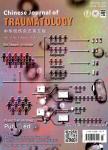Open reduction and internal fixation for displaced supracondylar fractures of the humerus in children with crossed K-wires via lateral approach
Open reduction and internal fixation for displaced supracondylar fractures of the humerus in children with crossed K-wires via lateral approach作者机构:Registrar Orthopedics SKIMS Medical College &Hospital Srinagar India Registrar Anaesthetist Hospital for Bone & JointSurgery Barzulla Srinagar India MBBS DNB physical Medicine and RehabilitationSrinagar India
出 版 物:《Chinese Journal of Traumatology》 (中华创伤杂志(英文版))
年 卷 期:2014年第17卷第3期
页 面:130-135页
核心收录:
学科分类:0403[教育学-体育学] 1002[医学-临床医学] 100210[医学-外科学(含:普外、骨外、泌尿外、胸心外、神外、整形、烧伤、野战外)] 10[医学]
主 题:Humeral fractures Fracture fixation,internal Bone wires Child
摘 要:Objective: To assess the therapeutic results of open reduction and internal fixation with crossed K-wires via lateral approach for displaced supracondvlar fractures of the humerus in children. Methods: We prospectively followed 52 children who presented with Gartland type 3 displaced supraeondylar fractures of the humerus and were managed by open reduction and internal fixation with crossed K-wires via lateral *** were 37 male and 15 female patients; average age was 7.39 years. The most common mechanism of trauma was fall while playing (n=23), followed by fall from height (n=20), road traffic accidents (n-5) and fall from standing height (n=2). In 2 cases, mode of injury was not available. The mean follow-up was 12 months and patients were assessed according to Flynn's criteria. Results: Lateral approach provided an excellent view of the lateral column between two nervous planes and enabled an anatomical reduction in all cases. Immobilizing the elbow at 90 degrees or more of flexion was not needed after cross K-wire fixation. Majority of patients regained full range of motion within 6 weeks of pin removal. Two patients had postoperative ulnar nerve injuries that resolved after pin removal. The common late complication of cubitus varus was not seen in any patient. Delayed presentation to the emergency department, repeated manipulations by bone setters and massage with edible oil were responsible for stiffness in 5 patients. Superficial pin tract infection was noted in 5 patients that resolved with dressings and antibiotics. No deep infection occurred. A detailed clinical examination and radiographic analysis was done at final follow-up. They included measurement of carrying angle and range of movements of both operated and normal sides, and radiographs of both upper limbs for comparison. According to Flynn's criteria, 90.4% patients showed satisfactory results. Conclusion: Lateral approach for open reduction and internal fixation of the widely-displaced



